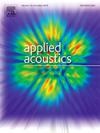Nonlinear modeling of the temperature coefficient of frequency of microacoustic resonators
IF 3.4
2区 物理与天体物理
Q1 ACOUSTICS
引用次数: 0
Abstract
Surface acoustic wave (SAW) filters play an essential role in radio frequency communications. To meet the demands of narrow guard bands, the temperature coefficient of frequency (TCF) of the filters must be deliberately controlled, which is closely related to the increasingly complex material system and boundary conditions. Consequently, modeling and accurate prediction of TCFs with previous theories has become a significant challenge. This research follows continuum mechanics to analyze the finite deformation in complex SAW resonator structures. Thermoelastic constitutive relations containing high-order nonlinear terms are developed for an accurate solution of the thermally induced finite deformation. A model for precise simulation of resonator TCF is developed, with the material and geometric nonlinearity effects from the finite deformation included in the effective material constants and field equation. Results from the developed model are compared against the experimental results for structures including temperature compensated SAW and wafer bonded SAW, thereby showing the accuracy of the model. Additionally, an improved piezoelectric-on-insulator (POI) based structure for SAW resonators is proposed with its performance comparable to commercialized thin film SAW (TF-SAW) technologies while resonant and anti-resonant TCFs differing lower than 10 ppm/∘C.

求助全文
约1分钟内获得全文
求助全文
来源期刊

Applied Acoustics
物理-声学
CiteScore
7.40
自引率
11.80%
发文量
618
审稿时长
7.5 months
期刊介绍:
Since its launch in 1968, Applied Acoustics has been publishing high quality research papers providing state-of-the-art coverage of research findings for engineers and scientists involved in applications of acoustics in the widest sense.
Applied Acoustics looks not only at recent developments in the understanding of acoustics but also at ways of exploiting that understanding. The Journal aims to encourage the exchange of practical experience through publication and in so doing creates a fund of technological information that can be used for solving related problems. The presentation of information in graphical or tabular form is especially encouraged. If a report of a mathematical development is a necessary part of a paper it is important to ensure that it is there only as an integral part of a practical solution to a problem and is supported by data. Applied Acoustics encourages the exchange of practical experience in the following ways: • Complete Papers • Short Technical Notes • Review Articles; and thereby provides a wealth of technological information that can be used to solve related problems.
Manuscripts that address all fields of applications of acoustics ranging from medicine and NDT to the environment and buildings are welcome.
 求助内容:
求助内容: 应助结果提醒方式:
应助结果提醒方式:


